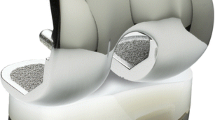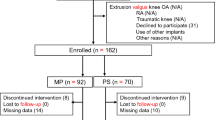Abstract
Introduction
The medial pivot total knee arthroplasty (TKA) has good patients’ satisfaction; however, there is likely the restriction of postoperative knee flexion. The 2nd generation medial pivot TKA prosthesis was designed to improve postoperative knee flexion. This study aimed to compare the clinical outcomes and patient satisfaction between the 2nd generation and 1st generation medial pivot TKA prostheses.
Materials and methods
We conducted a retrospective study of 472 consecutive TKAs, performed using either the 2nd generation (EVOLUTION™), having smaller posterior femoral condyle and asymmetrical tibial tray, or 1st generation (ADVANCE™) prosthesis. The use of each system was historically determined. Patient age, sex and body mass index were matched between the two groups, with 157 cases ultimately included in each group. Measured clinical outcomes included: knee range of motion, the Knee Society Score, the rate of re-operation, and radiological parameters. Patient satisfaction was evaluated using the 12-item Forgotten Joint Score (FJS-12).
Results
The average follow-up period was 5.0 (3.7–6.3) years for the 2nd generation group and 8.7 (6.1–12.8) years for the 1st generation group (p < 0.01). The postoperative knee flexion range was 127° (80°–140°) for the 2nd generation and 118° (90°–135°) for the 1st generation at final follow-up (p < 0.01). On multivariate regression analysis, use of the 2nd generation prosthesis predicted greater postoperative knee flexion. The average FJS-12 score was 64 (0–100) for the 2nd generation and mean 57 (0–100) for the 1st generation (p < 0.01). Other clinical outcomes were similar between the two groups.
Conclusions
Compared to the 1st generation, the 2nd generation medial pivot prosthesis provides greater postoperative knee flexion and patient satisfaction.


Similar content being viewed by others
References
Karachalios T, Varitimidis S, Bargiotas K et al (2016) An 11- to 15-year clinical outcome study of the advance medial pivot total knee arthroplasty. Bone Jt J 98B:1050–1055. https://doi.org/10.1302/0301-620X.98B8.36208
Macheras GA, Galanakos SP, Lepetsos P et al (2017) A long term clinical outcome of the medial pivot knee arthroplasty system. Knee 24:447–453. https://doi.org/10.1016/j.knee.2017.01.008
Bourne RB, Chesworth B, Davis A et al (2010) Comparing patient outcomes after THA and TKA: is there a difference? Clin Orthop Relat Res 468:542–546. https://doi.org/10.1007/s11999-009-1046-9
Mahomed N, Gandhi R, Daltroy L, Katz JN (2011) The self-administered patient satisfaction scale for primary hip and knee arthroplasty. Arthritis 2011:591253. https://doi.org/10.1155/2011/591253
Clary CW, Fitzpatrick CK, Maletsky LP, Rullkoetter PJ (2013) The influence of total knee arthroplasty geometry on mid-flexion stability: an experimental and finite element study. J Biomech 46:1351–1357. https://doi.org/10.1016/j.jbiomech.2013.01.025
Pan XQ, Peng AQ, Wang F et al (2017) Effect of tibial slope changes on femorotibial contact kinematics after cruciate-retaining total knee arthroplasty. Knee Surg Sport Traumatol Arthrosc 25:3549–3555. https://doi.org/10.1007/s00167-016-4384-7
Dalury DF, Barrett WP, Mason JB et al (2008) Midterm survival of a contemporary modular total knee replacement: a multicentre study of 1970 knees. J Bone Jt Surg Br 90:1594–1596. https://doi.org/10.1302/0301-620X.90B12.21064
Atzori F, Salama W, Sabatini L et al (2016) Medial pivot knee in primary total knee arthroplasty. Ann Transl Med 4:6. https://doi.org/10.3978/j.issn.2305-5839.2015.12.20
Samy DA, Wolfstadt JI, Vaidee I, Backstein DJ (2018) A retrospective comparison of a medial pivot and posterior-stabilized total knee arthroplasty with respect to patient-reported and radiographic outcomes. J Arthroplast 33:1379–1383. https://doi.org/10.1016/j.arth.2017.11.049
Øhrn FD, Gøthesen Ø, Låstad Lygre SH et al (2020) Decreased survival of medial pivot designs compared with cruciate-retaining designs in TKA without patellar resurfacing. Clin Orthop Relat Res 478:1207–1218. https://doi.org/10.1097/CORR.0000000000001120
Kim YH, Yoon SH, Kim JS (2009) Early outcome of TKA with a medial pivot fixed-bearing prosthesis is worse than with a PFC mobile-bearing prosthesis. Clin Orthop Relat Res 467:493–503. https://doi.org/10.1007/s11999-008-0221-8
Ha CW, Park YB, Song YS et al (2016) Increased range of motion is important for functional outcome and satisfaction after total knee arthroplasty in Asian patients. J Arthroplast 31:1199–1203. https://doi.org/10.1016/j.arth.2015.12.018
Minoda Y, Nakagawa S, Sugama R et al (2018) Joint gap in mid-flexion is not a predictor of postoperative flexion angle after total knee arthroplasty. J Arthroplast 33:735–739. https://doi.org/10.1016/j.arth.2017.10.030
Dennis DA, Komistek RD, Kim RH, Sharma A (2010) Gap balancing versus measured resection technique for total knee arthroplasty. Clin Orthop Relat Res 468:102–107. https://doi.org/10.1007/s11999-009-1112-3
Insall JN, Dorr LD, Scott RD, Scott WN (1989) Rationale of the knee society clinical rating system. Clin Orthop Relat Res 248:13–14
Kim Y-H, Sohn K-S, Kim J-S (2005) Range of motion of standard and high-flexion posterior stabilized total knee prostheses. A prospective, randomized study. J Bone Jt Surg Am 87:1470–1475. https://doi.org/10.2106/JBJS.D.02707
Behrend H, Giesinger K, Giesinger JM, Kuster MS (2012) The “forgotten joint” as the ultimate goal in joint arthroplasty. J Arthroplast 27:430-436.e1. https://doi.org/10.1016/j.arth.2011.06.035
Ewald FC (1989) The knee society total knee arthroplasty roentgenographic evaluation and scoring system. Clin Orthop Relat Res 248:9–12
Bauer GC, Insall J, Koshino T (1969) Tibial osteotomy in gonarthrosis (osteo-arthritis of the knee). J Bone Jt Surg Am 51:1545–1563. https://doi.org/10.5035/nishiseisai.21.87
Ritter MA, Harty LD, Davis KE et al (2003) Predicting range of motion after total knee arthroplasty. Clustering, log-linear regression, and regression tree analysis. J Bone Jt Surg Am 85:1278–1285. https://doi.org/10.2106/00004623-200307000-00014
Behrend H, Zdravkovic V, Bösch M, Hochreiter B (2019) No difference in joint awareness after TKA: a matched-pair analysis of a classic implant and its evolutional design. Knee Surg Sport Traumatol Arthrosc 27:2124–2129. https://doi.org/10.1007/s00167-019-05407-4
R Core Team (2014) R: A language and environment for statistical computing. R Foundation for Statistical Computing, Vienna, Austria
Bae DK, Do CS, Im SK, Song SJ (2016) Comparison of midterm clinical and radiographic results between total knee arthroplasties using medial pivot and posterior-stabilized prosthesis-matched pair analysis. J Arthroplast 31:419–424. https://doi.org/10.1016/j.arth.2015.09.038
De Muylder J, Victor J, Cornu O et al (2015) Total knee arthroplasty in patients with substantial deformities using primary knee components. Knee Surg Sport Traumatol Arthrosc 23:3653–3659. https://doi.org/10.1007/s00167-014-3269-x
Minoda Y, Ikebuchi M, Mizokawa S et al (2018) Asymmetric tibial component improved the coverage and rotation of the tibial component in a medial pivot total knee prosthesis. J Knee Surg 31:416–421. https://doi.org/10.1055/s-0037-1604143
Abdelnasser MK, Adi MM, Elnaggar AA, Tarabichi S (2020) Internal rotation of the tibial component in total knee arthroplasty can lead to extension deficit. Knee Surg Sport Traumatol Arthrosc 28:2948–2952. https://doi.org/10.1007/s00167-019-05695-w
Bayliss LE, Culliford D, Monk AP et al (2017) The effect of patient age at intervention on risk of implant revision after total replacement of the hip or knee: a population-based cohort study. Lancet 389:1424–1430. https://doi.org/10.1016/S0140-6736(17)30059-4
Van Overschelde PP, Fitch DA (2016) Patient satisfaction at 2 months following total knee replacement using a second generation medial-pivot system: follow-up of 250 consecutive cases. Ann Transl Med 4:339–339. https://doi.org/10.21037/atm.2016.08.41
Ingelsrud LH, Roos EM, Terluin B et al (2018) Minimal important change values for the Oxford knee score and the forgotten joint score at 1 year after total knee replacement. Acta Orthop 89:541–547. https://doi.org/10.1080/17453674.2018.1480739
Acknowledgements
We appreciate the contributions from all group members in the medical stuff of Osaka City University and Tanabe Central Hospital.
Funding
This study was not supported by any funding agencies in the public, commercial, or not-for-profit sectors.
Author information
Authors and Affiliations
Corresponding author
Ethics declarations
Conflict of interest
The authors declare that they have no conflict of interest.
Additional information
Publisher's Note
Springer Nature remains neutral with regard to jurisdictional claims in published maps and institutional affiliations.
Rights and permissions
About this article
Cite this article
Ueyama, H., Kanemoto, N., Minoda, Y. et al. Comparison of postoperative knee flexion and patient satisfaction between newly and conventionally designed medial pivot total knee arthroplasty: a 5-year follow-up matched cohort study. Arch Orthop Trauma Surg 142, 2057–2064 (2022). https://doi.org/10.1007/s00402-021-04121-6
Received:
Accepted:
Published:
Issue Date:
DOI: https://doi.org/10.1007/s00402-021-04121-6




